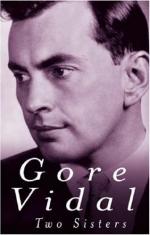|
This section contains 211 words (approx. 1 page at 300 words per page) |

|
Unlike more traditional autobiographical novels — works in which an author reshapes the materials of his own life to give them form and closure (for example, David Copperfield by Charles Dickens [1850] or The Naked and the Dead by Norman Mailer [1948]) — and in distinction from the biographical novel (such as Vidal's Burr, 1973), the sort of autobiographical novel Vidal is writing in Two Sisters fuses fact and invention by remaining true to the psychology of the author while inventing a fictional world for him to observe. In classic illustrations of this point of view, like The Moon and Sixpence (1919) and The Razor's Edge (1944) by W. Somerset Maugham or The Berlin Stories (1946) by Christopher Isherwood, the narrator participates only intermittently in the action. By encouraging the reader to confuse the thirdperson observer narrator with the author as a real person, works in this mode carry a greater sense...
|
This section contains 211 words (approx. 1 page at 300 words per page) |

|




